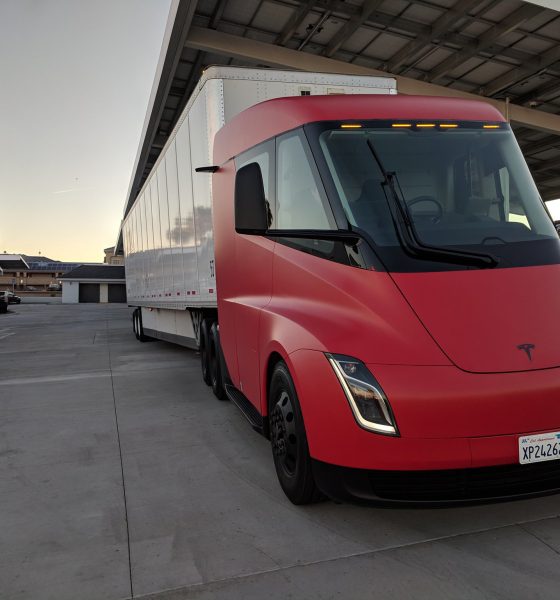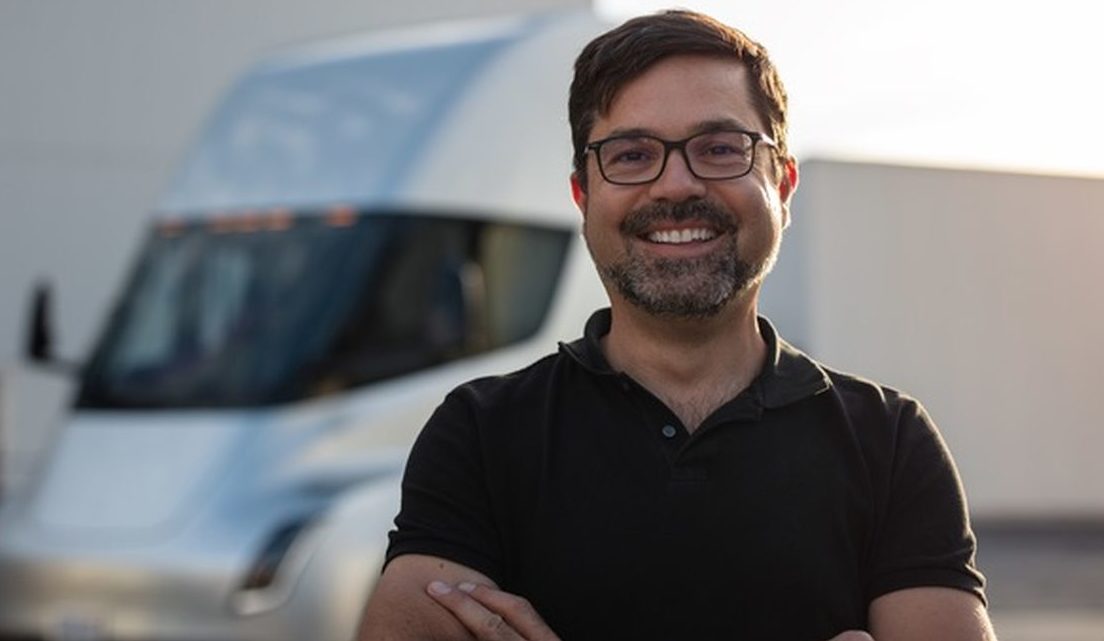

News
Tesla has a ‘Heavy Trucking’ division and it named Jerome Guillen as President
Tesla announced on March 11th, 2020, that it named President of Automotive Jerome Guillen as the President of the company’s Heavy Trucking division in an 8-K filing with the SEC.
Revealed earlier today, Guillen has assumed the role of Tesla’s Heavy Trucking division as its Semi project begins to gain more traction. Since 2018, Guillen has served as Tesla’s President of Automotive, a role that required him to oversee vehicle programs, supply chain, and service infrastructure.
Tesla Heavy Trucking President Jerome Guillen posing next to the Tesla Semi at Fremont Photo: Timothy Artman via La Provence
Tesla said in the filing:
“Effective March 11, 2021, Jerome Guillen, President, Automotive, of Tesla, Inc. (“Tesla”) transitioned to the role of President, Tesla Heavy Trucking. Since September 2018, Mr. Guillen has successfully overseen Tesla’s vehicle programs, supply chain and service infrastructure and contributed to the development of leaders, organizations and processes capable of continuing to direct and operate those functions for our passenger vehicle programs. As Tesla prepares to enter the critical heavy trucks market for the first time, Mr. Guillen will now leverage his extensive background in this industry to focus on and lead all aspects of the Tesla Semi program, including the related charging and servicing networks.”
ALSO READ:
Tesla Semi is leading the charge toward the phase-out of diesel trucks
Tesla’s Semi program has been in the works since the vehicle was unveiled in November 2017. Since then, Tesla has worked tirelessly to attempt to solve battery supply constraints that have effectively delayed the Semi’s initial production phases on several occasions. Production was scheduled to begin in late 2020 after Elon Musk revealed last year that the company should begin focusing on “volume production” of the all-electric Semi. However, it was revealed that there were not enough battery cells to handle the Semi project along with Tesla’s massive passenger vehicle production lines. Ultimately, the passenger vehicles, like the Model 3 and Model Y, took priority, and the Semi program was delayed.
Lately, there have been several sightings of the Semi in random public appearances. Some have seen slightly modified versions of the Semi on highways, others have seen them in trucking lots. However, the most recent sighting was released by Tesla itself when the company showed new footage of the vehicle ripping around the Fremont Factory’s test track. With the updates and more frequent sightings of the Semi, it is possible that Tesla could be moving closer to production.
Now that Tesla has also named Guillen as the President of its Heavy Trucking division, it seems that the automaker is taking an approach that is hinting toward the imminent arrival of the Semi.
Guillen’s new role is accompanied by several slight changes in Tesla’s managerial outlook. While CEO Elon Musk and CFO Zachary Kirkhorn remain with the company in their respective positions, their titles have been updated to “Technoking of Tesla” and “Tesla’s Master of Coin.”

News
Tesla starts showing how FSD will change lives in Europe
Local officials tested the system on narrow country roads and were impressed by FSD’s smooth, human-like driving, with some calling the service a game-changer for everyday life in areas that are far from urban centers.

Tesla has launched Europe’s first public shuttle service using Full Self-Driving (Supervised) in the rural Eifelkreis Bitburg-Prüm region of Germany, demonstrating how the technology can restore independence and mobility for people who struggle with limited transport options.
Local officials tested the system on narrow country roads and were impressed by FSD’s smooth, human-like driving, with some calling the service a game-changer for everyday life in areas that are far from urban centers.
Officials see real impact on rural residents
Arzfeld Mayor Johannes Kuhl and District Administrator Andreas Kruppert personally tested the Tesla shuttle service. This allowed them to see just how well FSD navigated winding lanes and rural roads confidently. Kruppert said, “Autonomous driving sounds like science fiction to many, but we simply see here that it works totally well in rural regions too.” Kuhl, for his part, also noted that FSD “feels like a very experienced driver.”
The pilot complements the area’s “Citizen Bus” program, which provides on-demand rides for elderly residents who can no longer drive themselves. Tesla Europe shared a video of a demonstration of the service, highlighting how FSD gives people their freedom back, even in places where public transport is not as prevalent.
What the Ministry for Economic Affairs and Transport says
Rhineland-Palatinate’s Minister Daniela Schmitt supported the project, praising the collaboration that made this “first of its kind in Europe” possible. As per the ministry, the rural rollout for the service shows FSD’s potential beyond major cities, and it delivers tangible benefits like grocery runs, doctor visits, and social connections for isolated residents.
“Reliable and flexible mobility is especially vital in rural areas. With the launch of a shuttle service using self-driving vehicles (FSD supervised) by Tesla in the Eifelkreis Bitburg-Prüm, an innovative pilot project is now getting underway that complements local community bus services. It is the first project of its kind in Europe.
“The result is a real gain for rural mobility: greater accessibility, more flexibility and tangible benefits for everyday life. A strong signal for innovation, cooperation and future-oriented mobility beyond urban centers,” the ministry wrote in a LinkedIn post.
News
Tesla China quietly posts Robotaxi-related job listing
Tesla China is currently seeking a Low Voltage Electrical Engineer to work on circuit board design for the company’s autonomous vehicles.

Tesla has posted a new job listing in Shanghai explicitly tied to its Robotaxi program, fueling speculation that the company is preparing to launch its dedicated autonomous ride-hailing service in China.
As noted in the listing, Tesla China is currently seeking a Low Voltage Electrical Engineer to work on circuit board design for the company’s autonomous vehicles.
Robotaxi-specific role
The listing, which was shared on social media platform X by industry watcher @tslaming, suggested that Tesla China is looking to fill the role urgently. The job listing itself specifically mentions that the person hired for the role will be working on the Low Voltage Hardware team, which would design the circuit boards that would serve as the nervous system of the Robotaxi.
Key tasks for the role, as indicated in the job listing, include collaboration with PCB layout, firmware, mechanical, program management, and validation teams, among other responsibilities. The role is based in Shanghai.
China Robotaxi launch
China represents a massive potential market for robotaxis, with its dense urban centers and supportive policies in select cities. Tesla has limited permission to roll out FSD in the country, though despite this, its vehicles have been hailed as among the best in the market when it comes to autonomous features. So far, at least, it appears that China supports Tesla’s FSD and Robotaxi rollout.
This was hinted at in November, when Tesla brought the Cybercab to the 8th China International Import Expo (CIIE) in Shanghai, marking the first time that the autonomous two-seater was brought to the Asia-Pacific region. The vehicle, despite not having a release date in China, received a significant amount of interest among the event’s attendees.
Elon Musk
Elon Musk and Tesla AI Director share insights after empty driver seat Robotaxi rides
The executives’ unoccupied tests hint at the rapid progress of Tesla’s unsupervised Robotaxi efforts.

Tesla CEO Elon Musk and AI Director Ashok Elluswamy celebrated Christmas Eve by sharing personal experiences with Robotaxi vehicles that had no safety monitor or occupant in the driver’s seat. Musk described the system’s “perfect driving” around Austin, while Elluswamy posted video from the back seat, calling it “an amazing experience.”
The executives’ unoccupied tests hint at the rapid progress of Tesla’s unsupervised Robotaxi efforts.
Elon and Ashok’s firsthand Robotaxi insights
Prior to Musk and the Tesla AI Director’s posts, sightings of unmanned Teslas navigating public roads were widely shared on social media. One such vehicle was spotted in Austin, Texas, which Elon Musk acknowleged by stating that “Testing is underway with no occupants in the car.”
Based on his Christmas Eve post, Musk seemed to have tested an unmanned Tesla himself. “A Tesla with no safety monitor in the car and me sitting in the passenger seat took me all around Austin on Sunday with perfect driving,” Musk wrote in his post.
Elluswamy responded with a 2-minute video showing himself in the rear of an unmanned Tesla. The video featured the vehicle’s empty front seats, as well as its smooth handling through real-world traffic. He captioned his video with the words, “It’s an amazing experience!”
Towards Unsupervised operations
During an xAI Hackathon earlier this month, Elon Musk mentioned that Tesla owed be removing Safety Monitors from its Robotaxis in Austin in just three weeks. “Unsupervised is pretty much solved at this point. So there will be Tesla Robotaxis operating in Austin with no one in them. Not even anyone in the passenger seat in about three weeks,” he said. Musk echoed similar estimates at the 2025 Annual Shareholder Meeting and the Q3 2025 earnings call.
Considering the insights that were posted Musk and Elluswamy, it does appear that Tesla is working hard towards operating its Robotaxis with no safety monitors. This is quite impressive considering that the service was launched just earlier this year.








